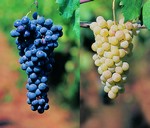
Tuesday evening I went to a wine tastin'. Actually, it was a preview to Vitigno Italia (an industry fair in Naples, though open to the public) that will happen in May 2007.
David informed me of this event as he did back in May (
click here to see the post about it).
Let me just backtrack by telling you that I have signed up for a"sommelier" class. It is the first of 3 levels, and it is given by
AIS (Association of Italian Sommeliers) in conjunction with the state organization,
Agripromos. It was amazingly cheap, as it is state subsidized. We all received a bag with 3 glasses, 3 books, and a free membership to AIS.
Anyway, what I hope to do by taking this class (besides getting to try lotsa classy hooch that I couldn't normally afford), is to refine my ability to analyze the organoleptic properties of wine (scents and smells), learn more about the wine-making process, and have at least one sip of every single Italian varietal in existence. To do the first, our teachers have told us that "ci vuole allenamento." That means we must train! That means I have to practice, people! That means going to as many tastings as I can, and studying like a good girl at home.
And what's wrong with a little sacrifice?
That leads me back to Vitigno Italia. Like I've said before, it is difficult to try every wine, and the way these people pour is not conducive to end-of-the-night lucidity. An important thing that I've learned is to dump ANYTHING that is not extraordinary. If it's not worth a second sip, don't dedicate your body's oxidizing power to it.

There were a few standouts, some wines that were odd, and lots of obscure autochthonous grapes. In the standout category, I tried an organic Brunello di Montalcino. There were tables of Banfi and compnay, but I felt pulled by the little guy, the winemaker who was pushing his OWN wine
(Poderi Salicutti) as opposed to the representative of an internationally recognized wine producer. I wanted to talk to the man who is progressing against the current to run an organic vineyard. He was soft-spoken but passionate about his work. He humored me by chatting away a good half-hour, and he let me try his Rosso di Montalcino, then his Brunello (both made with the local clone of sangiovese, brunello). Many tasters went straight for the Brunello, but I wanted to see the progression from the younger rosso (undergoes one year of barrel aging and 6 in the bottle) to the refined brunello (minimum 2 years in the barrel and 4 in the bottle). Having long ingnored Toscana in search of the less publicized regions, I have quite a bit of sensory learning to do. They were well-made and true to the tradition which are 2 things I am always searching for in this world of international varietals and market-driven techniques. In other words, I had a great time staining my teeth at his stand. That's him pouring his rosso,
and here's his site, if you're interested.
One of the odd wines that I tried was a Friulian pinot grigio that had been macerated on its skins. I've only heard of this process, so it was quite exciting to try, so exciting
that I don't remember the producer's name. It's unusual because white grapes are almost always pressed and separated from their juices right away, not allowing any influence from the skins into the final wine product. (Red grapes intended for red wine, however, are pressed then left on their skins, in most cases, for a couple of weeks to extract color, tannins, and some additional flavor components.)
The result was...strange. The wine had a coppery hue that's typical of the actual grape, and an odor that I had a hard time pinning down. It was slightly salty and vegetal, but I find it difficult to be any more specific. (MUST PRACTICE!) This pinot grigio didn't fit into my wine paradigm and for this, it was unforgettable. Has anyone else had one of these? Alfonso? David? They are built to age, as opposed to most whites, and I would like to see if it evolves into something more recognizable.
The autoctoni that I met were: ruche' (piemonte), foja tondo (veneto), tinitilia (molise), and maybe (surely) a couple of others that I don't remember.
Campania was represented mostly by a series of raspy, wily young aglianicos that needed to be

put in their places by a little bit of age. In fact, many of the big-structured grapes (sagrantino, nebbiolo, and 'dem crazy aglianicos) were opened far before their time. After all of these tannins, I found the primitivos of Puglia just a little too raspberry-ish to enjoy.
The no-show regions were Basilicata, Calabria, Sardegna, Le Marche, Trentino, and Liguria. I wanted to get my hands on some Franciacorta too (bubbly, of course), but I couldn't find Lombardia. Next time!
By the way, is it offensive to tell someone that their Negroamaro has a slight smell of the old-school band-aids that came in the tin can? I know for SURE that the Friulian producers would not have appreciated my whispered comment about their white tasting like Pace picante sauce. But band-aids? That smell reminds me of my childhood. A time when band-aids...well...came in a tin can. Maybe I should keep my mouth shut.
I'm sure for some of you out there, all of this wine-talk could easily be replaced by a long string of "blablabla," so I'll finish here and let you all get on with your lives.
Besides, I have me some practicin' to do.




















